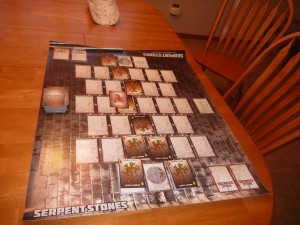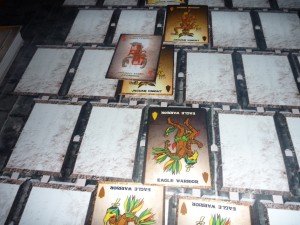First Look: Serpent Stones from from Dangermoose Entertainment
Wandering the floor at Vul-Con a few weeks ago, I happened upon a booth for “Serpent Stones,” a new card game from Dangermoose games. A Kickstarter project begins in June, but Dangermoose was kind enough to provide a prototype of the game for this article. Be warned that this is a prototype game, so this is not a review, just a first look at a new Kickstarter game project.
“Serpent Stones” (hereafter “SS”) draws on the ancient Aztec game “Itzcoatl.” Two players face off against each other and use cards to march across the board towards the opponent’s Temple Stone and occupy it. Each player chooses to play either Jaguar or Eagle warriors and begins on the appropriate side of the board. Each player draws seven cards, discards two and play begins. (Note: I played with slightly different mechanics. We played with a straight 5-card draw. This resulted in some really tough hands to play, so the 7-card draw helps. As I said, the game is still in development.)
Turns proceed with each player playing one card and then drawing one card. Players may play warriors from either faction and card direction determines ownership. Each “Serpent Stone” on the board can support only one warrior, so players must remove or convert opposing players. Attack or “Nahualli” cards come in two flavors, “Strike” and “Capture.”
My strike card eliminates the upside-down warrior from the opposing team. Attack cards have specific card configurations in red indicating where they land attacks. Note: I turned the destoryed card upside-down for clarity. The strike cards remove warriors, but the “capture” cards convert opposing warriors to your side. Since both players use a shared pool of warriors, team membership relies on a heads up/down mechanic. If the card is upside-down relative to you, it is an enemy. Elegant and it works well. This is the heart of the game; removing or converting warriors.
Since the board is wide, there are situations where killing/converting a warrior leaves a chain of cards without a direct path back to their home temple stone. You cannot play on this chain until you establish a renewed connection by playing in the empty stone space or re-capture the turned warrior.
To mix things up, there are some special cards that force discards and allow you to “sacrifice” cards to play in a later turn. The force discard is self-explanatory (interesting note; you can lose the game if you get hit with it and have no cards left. Makes card management critical to victory), but the sacrifice card need some explanation. A sacrifice is a special action that allows you place a card in a holding area and play it on a later turn. This ability costs you your current play. Sacrificing allows you to build up a reserve force that you can unleash in a single turn, rather than the usual one card mechanic. From my games, this is a critical part of the strategy and building a sacrifice pool is a painful, but necessary step.
Each game takes about 15 minutes, though they can run longer with cogitating players. “Serpent Stones” is simple to learn and strategically complex. I look forward to a retail version.
Assuming the kickstarter succeeds ( I believe it will), the released version comes out in October. Rather than a vinyl playing surface, SS will come boxed with a standard, printed cardboard playing surface and cards. I will let you know when the kickstarter goes up.
If you have any questions about the game, drop me a comment and I will contact Dangermoose to get you an answer.
Trask, The Last Tyromancer

